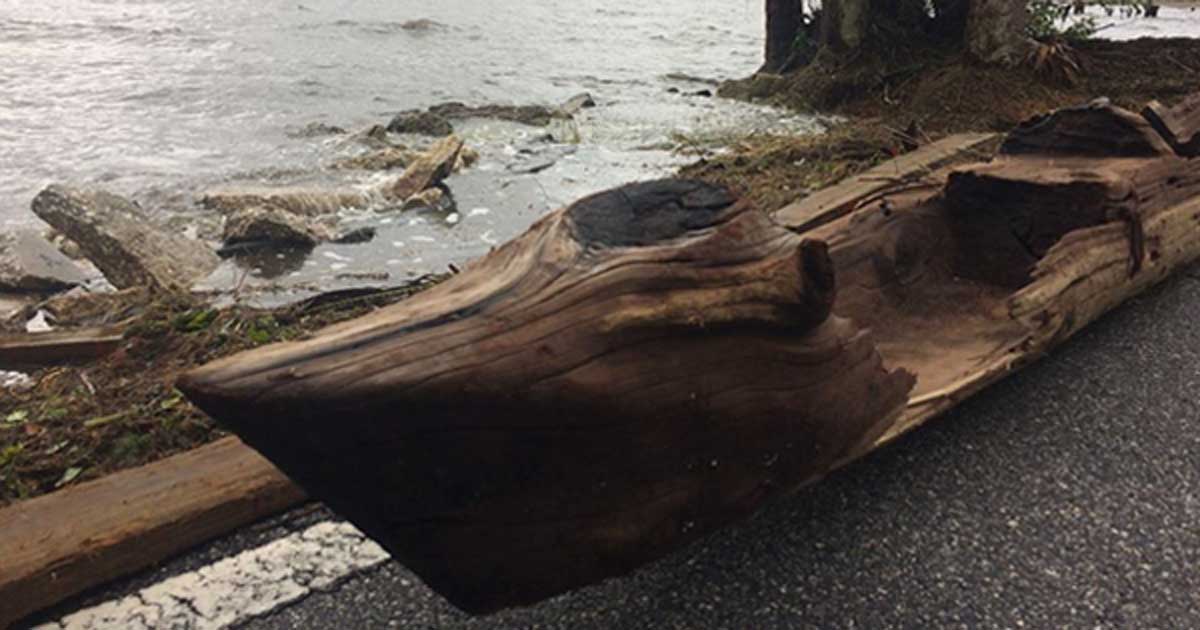Hurricane Irma Uncovers a Rare Native American Canoe in Florida
Hurricane Irma is believed to have unearthed what could be a centuries-old Native American canoe along the Indian River in Florida. The canoe was discovered by photographer Randy Lathrop who happened to be riding his bike along the river.
Hurricane Irma Unearths Centuries-Old Native American Canoe
While Hurricane Irma was merciless with many parts of Florida, it may have accidentally unearthed a “hidden treasure” a wooden Native American canoe that could be hundreds of years old. Randy Lathrop, a decorated art photographer, was on a bike ride to witness with his own eyes the damage that Irma caused to his coastal community of Cocoa, east of Orlando, when he noticed the odd object on the banks of the Indian River. “As soon as I saw it, I knew exactly what it was,” Lathrop told ABC News of his rare discovery. “Any time we have any kind of a storm, certain parts of our coastline are just swarming with [people with] metal detectors because they understand that items wash ashore after hurricanes,” he added.
- Why Isn’t This Map in the History Books?
- Evolution of a Native American Society: A Journey Through Ancient History
- The Native American Legend of the Sleeping Giant and the Whiteman

Cypress Dugout canoe found by Randy Lathrop by the Indian River after Hurricane Irma. (Image: Randy Shots)
Native American Canoes and their Unique Design
“I can look across the river and see the launch pad and the vehicle assembly building. It’s a real contrast,” Lathrop told ABC News of the area where the canoe was found, which is steeped in Native American history. Canoes were the main form of transportation used by Native American tribes living near rivers, lakes and oceans. The construction and style of canoe varies from region to region, but is most often dugout and bark styles. Indians built these birch-bark canoes by trial and error. Once they discovered a working form of the boat, it has not been improved much.
Most Indian canoes were lightweight, small, and fast, though the Iroquois built their canoes at lengths of 30 feet. These were used to hold up to 18 passengers or to help move merchandise. An advantage over a row boat is while in a canoe, you face forward in the direction of travel. Canoe designs varied from tribe to tribe but each canoe took quite a bit of talent to produce. Some were sewn together while others used spruce gum for caulking. Carving was essential and some burned the inside of the canoe to help it become waterproof.
- Did a Native American travel with the Vikings and arrive in Iceland centuries before Columbus set sail?
- Be Wary of the Wendigo: A Terrifying Beast of Native American Legend with an Insatiable Hunger to Devour Mankind
- A Glimpse into the Intuitive Medicine of the Native American Tradition

The area where the canoe was burned to help make carving easier and offer protection (Credit: Randy Shots)
Carbon Dating Determine the Canoe’s Age
Soon after discovering the rare canoe, Lathrop sent a text to a friend who specializes in underwater archaeology, and he responded with equal astonishment. He asked his friend to bring his truck to transport the canoe to another location. The narrow boat (15 feet in length and weighing almost 700 pounds) proved difficult to secure. They struggled with it, not only because of its weight, but also the bad weather wrought by Irma. “It looked just like a log,” Lathrop told ABC News. And added, “My main concern was to secure it from harm’s way. I was able to go half a mile away and get my friend with a truck and we struggled to get into the back of the truck. It weighs almost 700 pounds, but to me, it might as well have weighed 1,000 pounds. It’s been water soaked for years.”
In the meanwhile, Lathrop had contacted the Florida Division of Historical Resources before someone could mistake it for debris and throw it away. Sarah Revell, a spokeswoman with the department, stated that the 15-foot-long canoe could be anywhere from several decades to several hundred years old. “Florida is a treasure trove of unique history and we are excited about the recent discovery of the dugout canoe,” Revell told ABC News. “As we continue to evaluate and learn more about the canoe, our goal is to ensure it is preserved and protected for future generations in the local community and across Florida to learn from and enjoy,” she added.
Lathrop posted Facebook photos that were shared by nearly 75,000 people by Friday afternoon — and sparked online speculation as to the canoe's age. Ultimately, Duggins said radiocarbon-dating results should be finished within the next few weeks. “Plans and logistics for the canoe's long-term conservation and public display have not been finalized,” she told ABC News.
Top image: Cypress Dugout canoe found by Randy Lathrop by the Indian River after Hurricane Irma. (Image: Randy Shots)


















Comments
Great information.
Hurricane Imra has caused a lot of destruction. I agree with you these canoe constructions are ancient once, they are built in different ways there constructions differs. This is really great that you found it and indeed flodira has many more treasures hidden.
The hurricane has left an impact on life and property. After the impact of hurricanes now people in Florida are concerned about their property and they are upgrading it with the special info from http://stormguardwindowanddoor.com/ experts. There are some ancient constructions that are being updated to meet the building code standards. It is mandatory for all to meet the building codes that are specified.